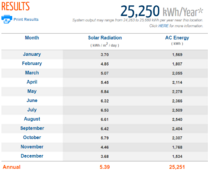TRSmith99
New Member
New joiner…. Hoping the experts can provide some insight!
We purchased a home in Northern California earlier this year. One goal is get the house “off grid” using solar. We’ve had 2 solar companies come out and - to be honest - the bids are staggering (~$100k).
Our situation:
We only have 5 months of energy usage at the house. We are in Northern California (Bay Area) and - as such - our weather is not severe by any means. We’ll get a few hot weeks in the summer (high temps in the 90s) but it still cools off every night. Winter highs are in the 50’s/60’s, with lows in the 40’s.
The house is a single-story mid-century modern. We’re currently connected to the local utility provider PG&E. Most of the house is electric - especially after a few recent upgrades (removed the central air/heater and replaced it with a heatpump; removed the 2 water heaters - 1 gas, 1 electric - and replaced with a gas on-demand unit). Working through replacing/upgrading all the lights to LEDs.
Power consumption in Jan/Feb (our coldest months) was ~1500kwh. March/April power consumption (after some of the upgrades) is materially lower - getting closer to ~1100kwh.
With logistics and trees, we’re looking at a ground-mount system. Our area gets a minimum of 5.2 h of sun in the winter. We’d like battery back-up for evenings as well as enough power (in case of a blackout) for 24-36 hrs. (Guessing that’s ~2 batteries).
The estimates (so far) have 28 - 42 panels, 1-2 inverters, and 2-3 batteries. Any suggestions, thoughts, insights would be appreciated!
We purchased a home in Northern California earlier this year. One goal is get the house “off grid” using solar. We’ve had 2 solar companies come out and - to be honest - the bids are staggering (~$100k).
Our situation:
We only have 5 months of energy usage at the house. We are in Northern California (Bay Area) and - as such - our weather is not severe by any means. We’ll get a few hot weeks in the summer (high temps in the 90s) but it still cools off every night. Winter highs are in the 50’s/60’s, with lows in the 40’s.
The house is a single-story mid-century modern. We’re currently connected to the local utility provider PG&E. Most of the house is electric - especially after a few recent upgrades (removed the central air/heater and replaced it with a heatpump; removed the 2 water heaters - 1 gas, 1 electric - and replaced with a gas on-demand unit). Working through replacing/upgrading all the lights to LEDs.
Power consumption in Jan/Feb (our coldest months) was ~1500kwh. March/April power consumption (after some of the upgrades) is materially lower - getting closer to ~1100kwh.
With logistics and trees, we’re looking at a ground-mount system. Our area gets a minimum of 5.2 h of sun in the winter. We’d like battery back-up for evenings as well as enough power (in case of a blackout) for 24-36 hrs. (Guessing that’s ~2 batteries).
The estimates (so far) have 28 - 42 panels, 1-2 inverters, and 2-3 batteries. Any suggestions, thoughts, insights would be appreciated!
Last edited:



